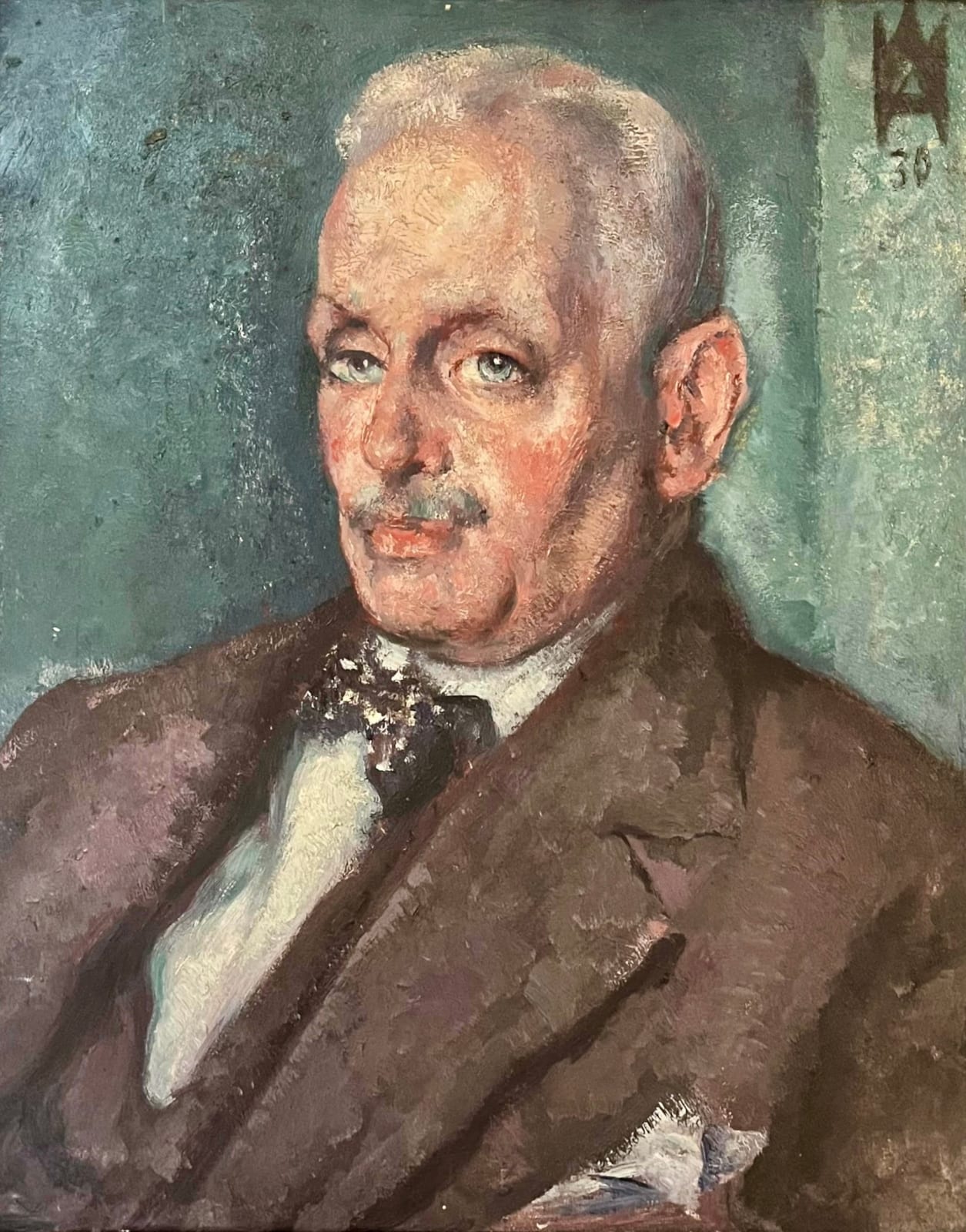
Alfred Wolmark (1877-1961)
Portrait of Rudolph Kohnstamm (1870 - 1940), 1930
Oil on panel
Signed in monogram and dated
Signed in monogram and dated
18 x 15 inches
Copyright The Artist
This distinguished portrait of Rudolf Kohnstamm, painted by the celebrated British modernist Alfred Wolmark, offers a rare insight into both the artist’s personal circle and the influential world of early...
This distinguished portrait of Rudolf Kohnstamm, painted by the celebrated British modernist Alfred Wolmark, offers a rare insight into both the artist’s personal circle and the influential world of early twentieth-century patronage.
Born in Germany in 1870, Kohnstamm emigrated to Britain, where he became a successful leather merchant. He made his home at 41 Frognal in Hampstead, London, and in 1896 married Emily Piza in Marylebone. Together with his brother Alfred, Rudolf became a generous supporter of leading artists of the time, notably Alfred Wolmark and Jacob Epstein.
The brothers’ close relationship with Wolmark led to the commissioning of several important works. One such painting, Portrait of Dottie Konstam (1915), which depicts Alfred Kohnstamm’s wife, was recently sold in Australia for one hundred and ten thousand four hundred and fifty-five Australian dollars, reflecting the ongoing demand for Wolmark’s portraits.
This jewel-like portrait of Rudolf Kohnstamm depicts a distinguished patron and close friend of the artist, aged sixty. Unlike most of the artist’s works, this piece remained in the Wolmarks’ personal collection throughout his life and was likely painted for his own enjoyment and contemplation. It was catalogued in Wolmark’s 1941 inventory under the number 136, where it is described simply as Portrait of Rudolf, 18 by 15 inches. With excellent provenance, historical depth, and expressive character, this work represents an important example of Wolmark’s mature portraiture and a deeply personal record of one of his most loyal patrons.
Wolmark’s use of delicately applied, pebble-dashed brushstrokes to render the sitter’s lapels and jacket demonstrates his mastery of light and texture, while also conveying a striking sense of volume and the proud bearing of the subject’s chest.
In contrast, Wolmark has applied much heavier daubs of paint to Rudolf’s face, using a delicate violet-grey palette in a sympathetic effort to depict his thinning hair. Wolmark’s true mastery, however, lies in his use of volume, which amplifies the figure to such an extent that he seems almost to project out of the frame.
Unlike most of the paintings an artist produces, this piece remained in Wolmark’s personal collection throughout his life, suggesting it was painted for his own enjoyment and contemplation.
In Wolmark’s 1941 inventory, under the number 136, it is described simply as Portrait of Rudolf, 18 by 15 inches. The corresponding number can be found on the reverse of the panel.
Born in Germany in 1870, Kohnstamm emigrated to Britain, where he became a successful leather merchant. He made his home at 41 Frognal in Hampstead, London, and in 1896 married Emily Piza in Marylebone. Together with his brother Alfred, Rudolf became a generous supporter of leading artists of the time, notably Alfred Wolmark and Jacob Epstein.
The brothers’ close relationship with Wolmark led to the commissioning of several important works. One such painting, Portrait of Dottie Konstam (1915), which depicts Alfred Kohnstamm’s wife, was recently sold in Australia for one hundred and ten thousand four hundred and fifty-five Australian dollars, reflecting the ongoing demand for Wolmark’s portraits.
This jewel-like portrait of Rudolf Kohnstamm depicts a distinguished patron and close friend of the artist, aged sixty. Unlike most of the artist’s works, this piece remained in the Wolmarks’ personal collection throughout his life and was likely painted for his own enjoyment and contemplation. It was catalogued in Wolmark’s 1941 inventory under the number 136, where it is described simply as Portrait of Rudolf, 18 by 15 inches. With excellent provenance, historical depth, and expressive character, this work represents an important example of Wolmark’s mature portraiture and a deeply personal record of one of his most loyal patrons.
Wolmark’s use of delicately applied, pebble-dashed brushstrokes to render the sitter’s lapels and jacket demonstrates his mastery of light and texture, while also conveying a striking sense of volume and the proud bearing of the subject’s chest.
In contrast, Wolmark has applied much heavier daubs of paint to Rudolf’s face, using a delicate violet-grey palette in a sympathetic effort to depict his thinning hair. Wolmark’s true mastery, however, lies in his use of volume, which amplifies the figure to such an extent that he seems almost to project out of the frame.
Unlike most of the paintings an artist produces, this piece remained in Wolmark’s personal collection throughout his life, suggesting it was painted for his own enjoyment and contemplation.
In Wolmark’s 1941 inventory, under the number 136, it is described simply as Portrait of Rudolf, 18 by 15 inches. The corresponding number can be found on the reverse of the panel.
Provenance
Private Collection, North LondonLiterature
Alfred Wolmark's 1941 inventory book 136 portrait of Rudolf 18 x 15 inchesJoin our mailing list
* denotes required fields
We will process the personal data you have supplied in accordance with our privacy policy (available on request). You can unsubscribe or change your preferences at any time by clicking the link in our emails.